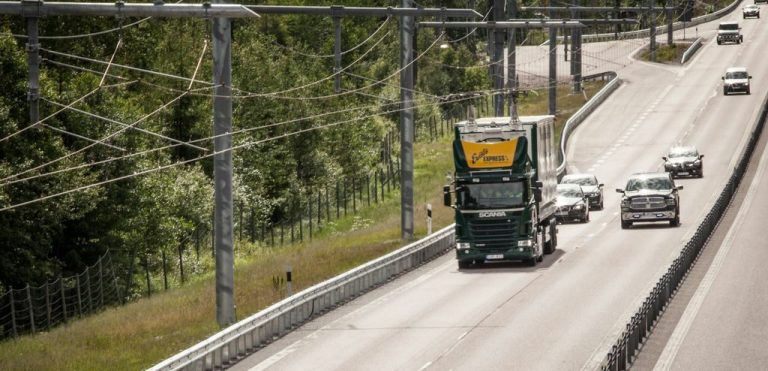Giverny Knezevic joined the Mobility Department as a research associate in May 2021. For the AMELIE II project, Knezevic researches methods for electrifying heavy-duty vehicle traffic to reduce emissions from freight transport. In a recent interview, she explained how lorries powered by overhead lines – catenary trucks – can contribute to decarbonisation strategies.
What is a catenary truck?
In the electromobility field, we explore topics related to stationary charging – for example, at charging points – as well as dynamic charging. Dynamic charging is carried out as part of an electrified road system, which refers to sections of road that enable electrical energy to be transferred to vehicles while they’re driving. So far, the technologies that have been tested include both inductive and conductive charging systems. Conductive charging is generally carried out via an overhead line. Catenary trucks have a current collector (called a pantograph) mounted on the roof of the cab that allows them to be powered using the overhead line. Trucks can then operate entirely electrically using a battery or draw additional power from a diesel engine (hybrid). A catenary truck powered by overhead lines can use a much smaller battery, which requires fewer resources and adds cargo space. It also makes it unnecessary for the truck to stop at charging points along the way.
How can catenary trucks contribute to reducing carbon emissions?
In 2021, the transport sector emitted more greenhouse gas emissions and registered a higher volume of traffic than in 2019. The transport sector is heavily dominated by trucks, which account for over 70% of the sector’s hauling capacity. To make freight transport ‘climate friendly’, the first step should be reducing the use of heavy-duty trucks for long-distance transport. The next priority should be a shift from vehicles to rail, but there’s limited potential to do so in the short to medium. That’s where the electrification of freight road transport can play an important role. The use of overhead contact line systems to power heavy-duty trucks has proved to be an efficient solution that’s ready for immediate implementation. It was developed over 10 years ago and has already been tested in several German and international projects. The technology can be used to decarbonise heavy-goods traffic quickly and relatively cheaply.
What are the challenges involved with introducing catenary trucks on a large scale?
The German government Overall Concept for Climate-friendly Commercial Vehicles’, technology path decisions for decarbonising heavy freight transport are to be made in the next few years. This decision is elementary for the large-scale market ramp-up in Germany. Furthermore, the technology needs more acceptance. When I started working on the AMELIE II project, I was a bit sceptical about the technology. But the more I learned about the subject, the more certain I became that this technology represents our best chance to make freight transport climate friendly in the near term. As far as alternative propulsion systems are concerned, green hydrogen has a much better image, but unfortunately, it’s not yet as readily available in the quantities needed.
In what ways is IKEM trying to improve the conditions for the usage of catenary trucks? How does IKEM’s recently released study contribute to this effort?
In the study, we outline what the operation of such a catenary truck could look like in concrete terms. We determined which stakeholders are involved and how they relate to each other, and then produced a detailed model that identifies who should operate the overhead line, which stakeholders are assigned which tasks, and what kinds of legal relationships exist between them. The mobility provider is a new stakeholder in the model. Every user of the overhead contact line should have its own mobility provider that supplies it with electricity. As in the case of ‘normal’ electricity suppliers, there should be competition between the mobility providers for the supply of traction current. It’s important to think about these issues before the technology is launched on the market so that legislative adjustments, standards, subsidy programmes and other necessary aspects can be initiated at an early stage.
We also regularly organise workshops on various topics, such as billing and planning, as well as meetings to discuss issues related to electric road systems with other experts at a European level.
What is the outlook for the use of catenary trucks in Germany, in Europe and around the world?
In the next few years, test tracks will be built in Bavaria and in Baden-Württemberg, with overhead lines placed along longer road sections for the first time. These are being created in the context of ‘innovation clusters’ and will make it possible to study various propulsion technologies in their entirety. According to the government strategy, there will be a decision in the next 2–3 years as to whether or not overhead lines will be built throughout Germany. Germany is taking a pioneering role here. If the decision is to move ahead with overhead lines, it’s likely that other EU member states will join in using the technology.
The most important (upcoming) legal act at EU level is the Alternative Fuels Infrastructure Regulation. This specifies how many charging points, hydrogen refuelling stations, etc. each EU country must build. The new proposal doesn’t yet include any specific requirements for electric road systems, but this could change in the next round of reviews, once Germany has reached a decision. Different kinds of road system technologies are currently being tested in various countries. Sweden is testing the conductor rail, for example, and France is also currently leaning more towards the conductor rail. But the technologies aren’t necessarily mutually exclusive. Each approach should be considered objectively for different applications. No EU country has chosen a path forward yet. In any case, it will be exciting to see what happens in the next few years.



